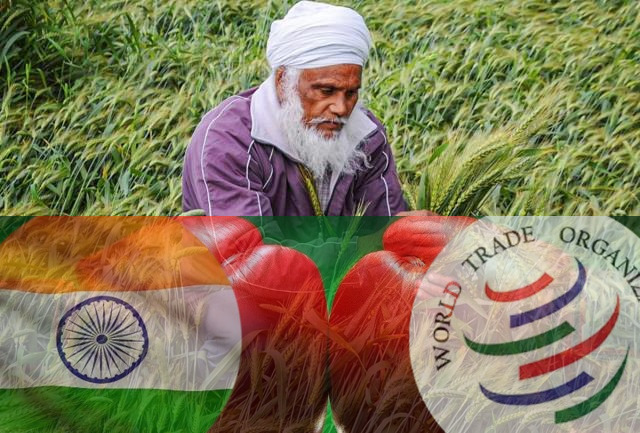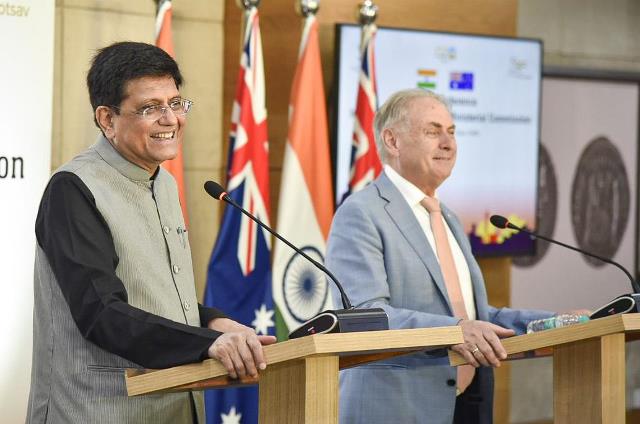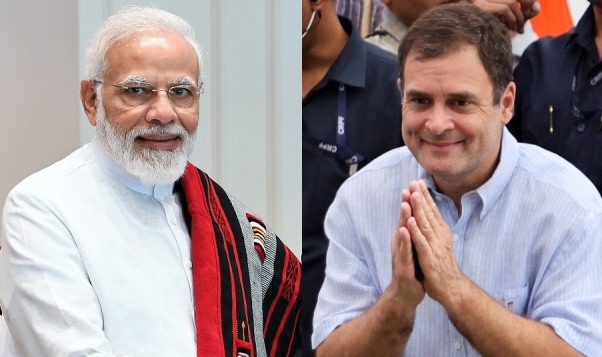One of the farmer leaders called for India to exit the World Trade Organisation. India is engaged in tactical bargaining at WTO to retain minimum support price (MSP). The WTO is desperate to reach outstanding issues of the current Agreement on Agriculture while many ordinary supporters of farmers are accusing the Indian Government of siding with corporates. In this article we explore the facts and how each is stuck in a complex muddy field from which there are few ways out.
Let us start with MSP, or Minimum Support Price. A simple fact of agriculture is that farming is no longer a subsistence occupation. Subsistence farming used natural fertilisers such as manure and farmers practised crop rotation, keeping the soil healthy. Farmers mostly produced for themselves and sold some in the market.
However, as population and life spans grew in India, traditional farming could not meet the growing demand. India had to go to international markets to buy staple foods such as grain and rice to feed its population. Often, India didn’t have enough money and borrowed it or went with a begging bowl for cheaper grain. It was ridiculed and was open to pressure by donor countries. An empty stomach is at the mercy of the provider.
The Green Revolution was a kick-start to move towards food security and self-sufficiency. The prerogative was to produce enough basic foods to feed all of India and keep enough in store for difficult times and even export. India was willing to subsidise this juggernaut of self-sufficiency drive. It changed small farmers to become small commercial farmers.
Farmers now use nitrogen-based fertilisers, all year supply of water with ever deeper mechanised wells (tube wells), and seasonal labour. Now they farm to sell rather than just feed the family. They have mostly abandoned rotation farming, growing 2-3 crops a year on the same plot of land, almost sucking life out of the land.
The inputs such as water, diesel, electricity, labourers, seeds, fertilisers, pesticides, hiring tractors or owning one on hire purchase etc all amount to considerable expense. India’s farms are small, with about 86% of farms ranging from 1-3 acres. They are family owned.
There are about 125 million farmers in India. About 58% of the Indian population depends directly or indirectly on farming sector with jobs ranging from farmer, farm labourers, traders, labour for traders, truck drivers, assistants and so on.
The Government provides many support structures and incentives, such as a well-developed procurement system called the mandi system. The Government buys the grain from farmers and ensure a minimum price so farmers can make profit. This is called Minimum Support Price or MSP. Usually it is direct input costs, called A2 and others such as unpaid family time, labelled as F1 plus 50% to 85% top up, depending on the crop, to make farming viable for the family. There was meant to be another factor called C2 which is unpaid rental and interest on fixed capital of the land. This has not been instituted. Farmers still find it difficult to make a reasonable living.
ALSO READ: Understanding the Mandi System in India
In theory, MSP is given to 22 crops products listed as essential commodities. But in reality only a few products get it and not all states provide it. It is mainly Punjab, Haryana and some parts of Himachal Pradesh. Rice and wheat are among leading crops that the Government pays for.
The road to food security is expensive but the country has become self-sufficient. It no longer goes with the begging bowl for basic foods such as rice and grain. In fact it has the capacity to export them.
The alternative is to buy basic foods in the international market from countries like Canada, Australia, United States and some other countries. Farms in these countries are an average 400 acres and in Australia can be as large as 25,000 acres. By economies of scale, these farms can buy fertilisers cheaper, have few labourers per acre of land and much fewer machinery per acre. Only a few tractors are needed for a 400 acre farm, whereas in India every 3 acre farm has to hire a tractor, wait their turn to hire or buy a tractor for their small farm.
It is not difficult to understand why cash crops can be produced cheaper by these countries with larger farms. The farms are bigger partly because these are the new worlds where land was plenty. In India and Africa, farming has been in families for centuries if not thousands of years.
If India buys on the open market and stops subsidising its farming, it will be open to the uncertainties of international politics. Other countries could demand more than money in return for selling cheaper wheat. The recent Ukraine conflict has shown how African countries dependent on Ukrainian wheat nearly faced starvation until Russia stepped in.
The other alternative is for India to go the way of some western countries and drive small farmers out in favour of large corporate Agri Business as USA did. Subsidies can be smaller and production can be cheaper with overheads spread over large area. However, that also means over a 100 million of not more farmers thrown into the job market without any jobs available. And another 300 to 600 million people dependent on the farm sector being made jobless. Politically, it will be suicide for any party to go down this route and nationally there could be unrest with nearly 50% of the population unemployed. MSP supported farming can be considered to be a form of indirect social security for farmers in return for ensuring food sovereignty.
The WTO
However, India faces another pressure, the World Trade Organisation or WTO. It took over from GATT, the General Agreement on Trade and Tariffs, in January 1995. WTO is market orientated and concerned about ensuring international trade being conducted fairly and competitively. It does not like subsidies which it calls market distortion. And it also negotiates and sets limits on tariffs which are taxes on imports.
Distortions occur if two countries, A and B manufacture the same product, for instance a ceramic plate. If production costs in country A is ₹10 a plate and in country B it is ₹8 a plate, then country B is likely to be able to sell more of it. However, country A may decide to subsidise every plate by ₹5 and thus enable the manufacturer to sell for ₹5 on the international market, undermining country B. This is distorting the market with a subsidy.
On the other hand, country A may decide that any plates imported from country B will be taxed ₹5. This pushes the price of country B plate ₹to 13. This will ensure that people in country A will buy the plates made by their own country at ₹10 rather than ₹13 a plate from country B. This is called protective measures and also distorting the market.
The Agreement on Agriculture (AOA) first came into force on 1st January 1995. It sought to put limits on subsidies. The AOA has three categories of subsidies. Green subsidies are permitted in fields such as training for farmers, which does not distort the market. Amber Box subsidies are market distorting subsidies. It was agreed that developed countries such as Canada, USA etc can give up to 5% subsidy. Developing countries such as India, China and most of the South can give up to 10% subsidy. The Blue box subsidy is where State subsidises to prevent over production and thus stop market distortion. This could be putting limits on production or giving money for uncultivated land set aside for environmental purposes.
The 5% subsidy for developed countries is a lot of money for a farmer with 400 acres. However 10% subsidy for a farmer with 3 acres of land does not make farming viable. India has been defying this by giving 50% to 85% subsidies. Clearly, WTO is not happy. Or rather some countries in WTO are not happy.
A group of 17 countries, known as the CAIRNS group, want WTO to impose these subsidy limits on countries like India. Leading them are Canada, Australia and USA. Australia brought a case against India on its 85% sugarcane subsidy. India lost that.
USA, Canada and Australia particularly want to bring a case on wheat subsidy in India. These countries know that the agriculture sector could collapse in India and India may be forced to buy wheat from them. They want to penetrate the big Indian market.
WTO and INDIA
Under Dr Manmohan Singh and now Narendra Modi, India has resisted this pressure. India wants WTO to allow it to continue with high subsidies. Its food sovereignty depends on that. The Modi government has been withholding consent on some other agreements until these concessions are agreed, particularly on tariffs for e-commerce. In the current 2024 round at Abu Dhabi, Piyush Goyal, the Industry and Commerce minister, scuppered any agreement on fishing stocks as India cannot afford not to give subsidies to fishermen and farmers.
WHAT NOW
There has to be 100% consent for a WTO agreement to become binding. India will no doubt continue to resist any pressure to reduce subsidies. One way forward is for the Agreement on Agriculture to come out of WTO and be handed to UNCTAD, the United Nations Conference on Trade and Development. WTO is not obliged to be cognisant of human rights, sustainable development goals, right to family life, right to education etc as it is not a UN body. But UNCTAD is a UN body and its policies and agreements have to align with those conventions.
WHAT SHOULD INDIA AND FARMERS DO.
Some farmers are arguing that there should be MSP for all crops. This is not feasible and is not really part of a food sovereignty approach. The Government is mindful of the impact on environment and water. Farmers and Indian government need to work together internally to achieve sensible policies and internationally to force changes at WTO or take Agreement on Agriculture out of WTO.
For more details visit us: https://lokmarg.com/




